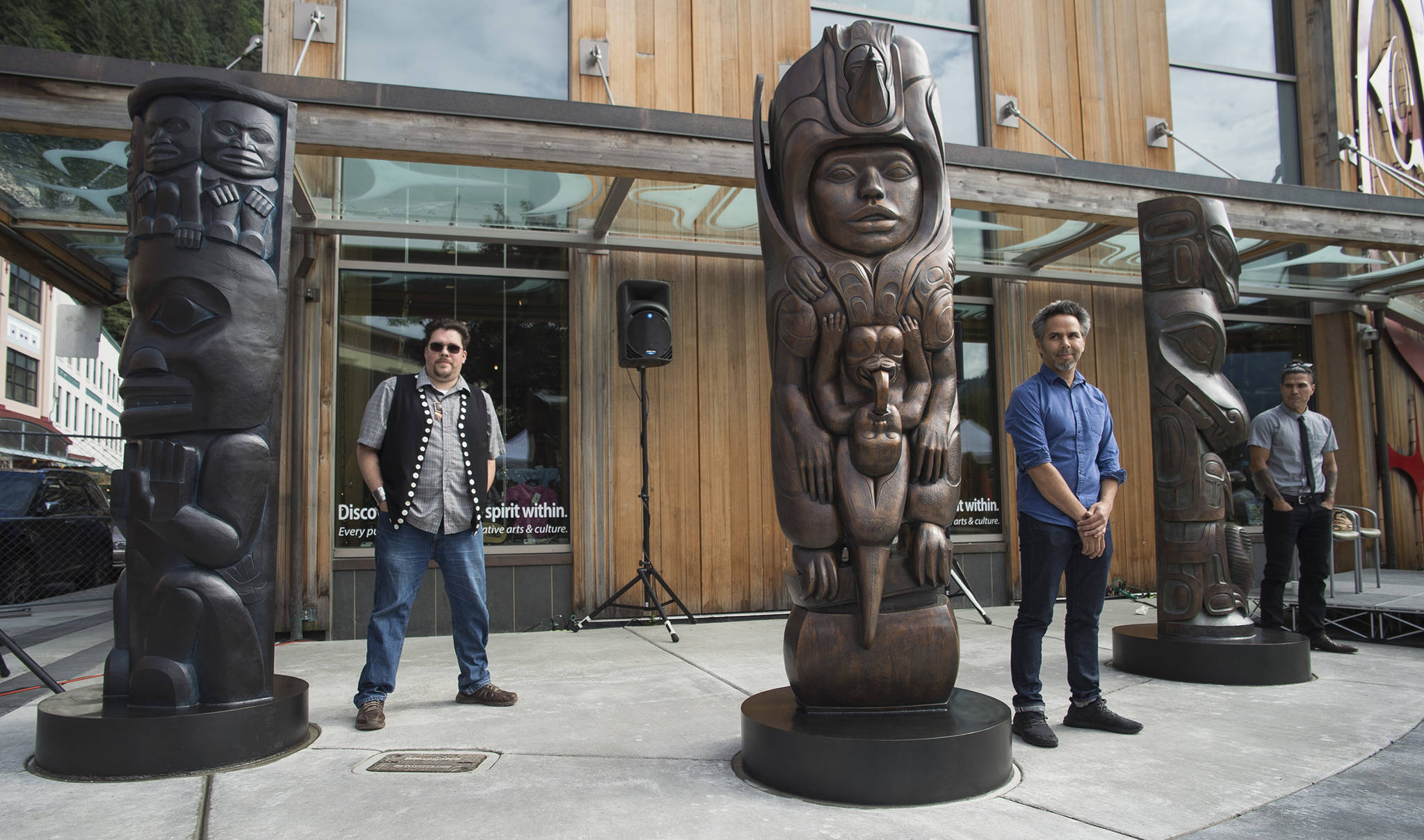The three bronze posts unveiled under sunny skies Sunday afternoon also double as pillars.
They hold up and support the vibrancy and resilience of the Tsimshian, Tlingit and Haida cultures.
“We are not just a part of history, we are here and living our way of life,” said Rosita Worl, Sealaska Heritage Institute president, during a ceremony held in front of the Walter Soboleff Building. “These bronze posts are symbols of our past and symbols of our future.”
Each 8-foot-tall post at the corner of Front and Seward streets was carved respectively by a Tsimshian, Tlingit and Haida artist before casts were made and enduring, bronze versions were created in a Seattle foundry.
“That they’re made in bronze makes a statement of our current real lives. … It’s an opportunity to show our cultures are alive and vibrant,” said David R. Boxley, Tsimshian artist, prior to the unveiling of the house posts.
Boxley, Stephen Jackson, a Tlingit artist, and TJ Young, a Haida artist, each carved a post and were at Sunday’s ceremony for the unveiling.
“I think it’s a privilege to do what I do, to carve for a living,” Young said.
Each artist said they were pleased their work would be presented in tandem with other highly skilled carvers, whom they consider friends.
They also were glad their posts will have long lives in a public space.
“There was a period of time when people thought this art was dying — the carving, the traditions, the mastery associated with such art was no longer present to the people, so I think this provides another opportunity to the people to see the work of a new generation of artists perhaps,” Jackson said.
They were joined at the roughly 90-minute unveiling ceremony by elected officials, Sealaska Corp. and Sealaska Heritage Institute leaders, and prominent community members, who also spoke during the ceremony.
“This will be a place to celebrate,” said Lt. Gov. Byron Mallott, who is also a Tlingit leader. “This is just the beginning, and the end is nowhere in sight.”
The presentation was also an exhibition of traditional dance and language.
The Woosh ji.een and Yees Ku Oo dance groups performed, and various speakers peppered their statements with indigenous language.
Boxley delivered his remarks in both the Tsimshian language Sm’algyax and English.
“While these posts are going to last a very long time, our language’s art won’t if we don’t do more,” Boxley said.
The posts
At a glance, the differences among the posts are immediately evident.
Boxley’s post features cheek pyramids characteristic of Tsimshian works as well as detailed faces and blocky appendages.
That post depicts Txeemsm, or Raven, topped by four figures representing four different Tsimshian clans.
“I really tried to make it look like an old Tsimshian post,” Boxley said.
Jackson noted his Tlingit post stands in the center of the trio and features some asymmetry, roughness and rawness.
His post represents the story of the woman who gave birth to the Raven, and its center is an emerging infant.
“You’re looking for something unknown or that feels unknown, uncertain, and so the uncertainty of that moment and the complexity with which people describe relationships in a matrilineal culture and how to provide the power to women, and still the complexity therein where there’s uncertainty of how that’s done is interesting to me,” Jackson said.
Young’s post features many form lines and emphasizes realism, which Young said are general traits of Haida art.
The fearsome, orca-hunting Wasgo, or seawolf, was the focus on Young’s piece.
He chose the subject matter because as a boy, the story of a lazy son-in-law who could change into a creature capable of hunting whales grabbed his attention.
“It’s one of those stories when you’re a kid, it makes you excited,” Young said.
The posts also share commonalities.
Each began as a cedar log, and they all took multiple months of work from the artists and assistants.
The original, wooden version of the posts were transferred to Sealaska and will be painted this week and later displayed at the waterfront side of the Sealaska building.
The posts were all also the first time Young, Jackson and Boxley had made a piece in bronze. They uniformly said they were pleased with the results.
“I’m really happy,” Boxley said. “It’s not what I pictured, but I’m thrilled with the outcome. Whatever I pictured isn’t what happened, but reality is better.”

